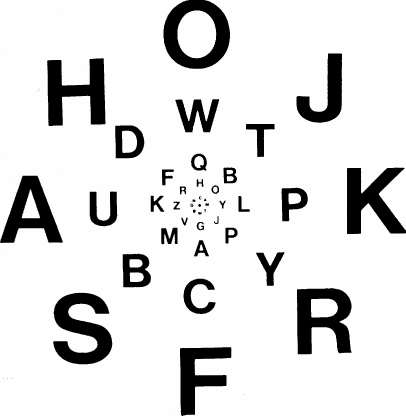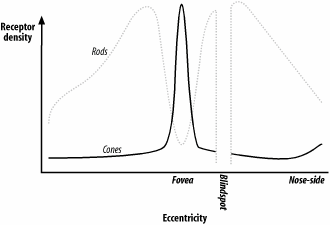Hack14.See the Limits of Your Vision
|
Hack 14. See the Limits of Your Vision
The high-resolution portion of your vision is only the size of your thumbnail at arm's length. The rest of your visual input is low res and mostly colorless, although you seldom realize it. Your vision isn't of uniform resolution. What we generally think of as our visual ability, the sharpness with which we see the world, is really only the very center of vision, where resolution is at its highest. From this high-resolution center, the lower-resolution periphery, and using continual movements of our head and eyes [Hack #15], we construct a seamlessand uniformly sharppicture of the universe. But how much are we compensating? What is the resolution of vision? The eye's resolution is determined by the density of light-sensitive cells on the retina, which is a layer of these cells on the back of the eye (and also includes several layers of cells to process and aggregate the visual signals to send on to the rest of the brain). If the cells were spread evenly, we would see as well out of the corners of our eyes as directly ahead, but they're not. Instead, the cells are most heavily packed right in the center of the retina, a small region called the fovea, so the highest-resolution part of the vision is in the middle of your visual field. The area corresponding to this is small; if you look up at the night sky, out of everything you see, your fovea just about covers the full moon. Away from this, in your peripheral vision, resolution is much coarser. Color also falls off in peripheral vision. The light-sensitive cells, called photoreceptors, come in different types according to what kinds of light they convert into neural signals. Almost all the photoreceptors that can discriminate colors of light are in the fovea. Outside of this central area you can still make out color, but it's harder; the oter type of cell, more sensitive but able to recognize only brightness, is more abundant. 2.3.1. In ActionFigure 2-1 is a variant of the usual eye chart you will have encountered at the optometrist, constructed by Stuart Anstis. Hold it in front of you, and rest your gaze on the central dot. The letters in the chart are smallest in the middle and largest at the outer edge; they scale up at a rate to exactly compensate for your eyes' decrease in resolution from the central fovea to the periphery. Figure 2-1. When you fixate on the center of this chart, all the letters are scaled to have the same resolution1 That means that, holding your gaze on the center of the chart, it should be as easy for you to read one of the letters near the middle as one of the bigger ones at the edge. What this eye chart doesn't show is our relative decrease in color-sensing ability as we edge toward peripheral vision. Have a friend hold pieces of colored card up to the side of your face while you keep your head, and eyes, looking forward. Notice that, while you can see that she's moving the card off in the corner of your eye, you can't tell what color the card is. Because peripheral vision is still good at brightness, you'll need to use pieces of card that won't give you any clues simply from how bright the card looks. A dull yellow and a bright blue will do. If you'd like to perform a more rigorous experiment, the Exploratorium museum provides instructions on how to make yourself a collar to measure the angles at which your color vision becomes useful (http://www.exploratorium.edu/snacks/peripheral_vision.html).
2.3.2. How It WorksWhen you're looking at Anstis' eye chart, Figure 2-1, all the letters are equally legible because the light from each is falling on the same number of photoreceptors at the back of the eye. The central letters fall in the center of your retina, where the photoreceptors are densest; the outer letters fall in the periphery where the cells are spread thinner, but the letters are larger so the same number of cells are covered. The distribution of light-sensitive cells across the retina is shown in Figure 2-2. There are two different curves, one for rods and one for cones, corresponding to the two types of photoreceptor cells we possess, so named because of their shapes. You can see how they're both densest toward the center of the eye and drop away toward the periphery, although at different rates. Assuming you're reading this book in anything above dim light, you'll have been using your cones to look at the eye chartthey're the ones that drop away fastest, and that rate determines the resolution of vision. Figure 2-2. The distribution of different photoreceptors on the retina2 That's why our color vision suffers outside the fovea. Cones work best in normal, daytime light levels, and they also respond to color. But the rods are relatively more numerous outside the fovea, and they don't respond to color. They're also extremely sensitive to light, so during the day they're not too much help at all, but you can still see how they're useful when cones are sparse. They're why you could see your friend moving the colored card in the earlier experiment, but they couldn't help you figure out whether the card was yellow, blue, or whatever. Rods, because of their sensitivity to light, are also handy when light is very poor. In dim conditions, our cones shut down (over a period of about 5 minutes) and we use our rods to see (the rods reach maximum sensitivity after about half an hour). But notice that rods are actually densest just outside the fovea, which means the best way to spot really faint light is to look at it slightly off-center. You can use this to look for faint stars on a dark night, and you'll see slightly more stars slightly outside the exact center of your vision. Curiously, aside from experiments like the colored card one, you don't normally notice that not all of your visual world is high resolution. This is because you move your eyes to what you want to look at, and as you move your eyes, the area of high resolution follows. This process of active vision [Hack #15] is much more efficient than having high resolution everywhere. Of course, before you move your eyes to something, your visual system has to preconsciously spot it using your peripheral vision and move your attention there. The events best noticed by peripheral vision are described in [Hack #37] and are mainly sudden changes of movement and light. These are events that signify that something needing an urgent response could be happeningit's not surprising we are designed to notice them even outside the high-resolution center of the eye. 2.3.3. End Notes
2.3.4. See Also
|
|
EAN: N/A
Pages: 159